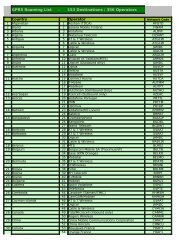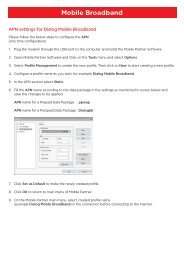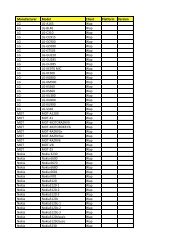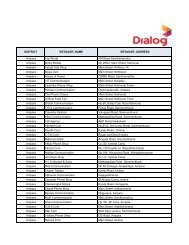Annual Report 2012 - Dialog
Annual Report 2012 - Dialog
Annual Report 2012 - Dialog
You also want an ePaper? Increase the reach of your titles
YUMPU automatically turns print PDFs into web optimized ePapers that Google loves.
<strong>Annual</strong> <strong>Report</strong> <strong>2012</strong> l <strong>Dialog</strong> Axiata PLC l 69<br />
The liability recognised in the statement of financial position in respect of defined benefit plan is the present value of the<br />
defined benefit obligation at the date of the statement of financial position together with adjustments for unrecognised pastservice<br />
costs. The defined benefit obligation is calculated annually by independent actuaries using the projected unit credit<br />
method. The present value of the defined benefit obligation is determined by discounting the estimated future cash outflows<br />
using appropriate interest rates by the actuarial valuer.<br />
Past-service costs are recognised immediately in statement of comprehensive income, unless the changes to the defined<br />
benefit plan are conditional on the employees remaining in service for a specified period of time (the vesting period). In this<br />
case, the past-service costs are amortised on a straight-line basis over the vesting period.<br />
Actuarial gains and losses arising from experience adjustments and changes in actuarial assumptions are recognised<br />
immediately in the statement of comprehensive income.<br />
The assumptions based on which the results of the actuarial valuation was determined, are included in note 24 to the<br />
financial statements.<br />
(b) Defined contribution plans<br />
For defined contribution plans, such as the Employees’ Provident Fund and Employees’ Trust Fund, the Company and the<br />
Group contribute 12% or 15% and 3% respectively, of the employees’ basic or consolidated wage or salary. The Company<br />
and the Group have no further payment obligation once the contributions have been paid. The Company and the employees<br />
are members of these defined contribution plans.<br />
(c) Short term employee benefits<br />
Wages, salaries, paid annual leave and sick leave, bonuses and non-monetary benefits are accrued in the period in which<br />
the associated services are rendered by employees of the Company and the Group.<br />
(d) Termination benefits<br />
Termination benefits are payable whenever an employee’s service is terminated before the normal retirement date or<br />
whenever an employee accepts voluntary redundancy in exchange for these benefits. The Company and the Group<br />
recognise termination benefits when it is demonstrably committed to either terminate the employment of current employees<br />
according to a detailed formal plan without possibility of withdrawal or to provide termination benefits as a result of an offer<br />
made to encourage voluntary redundancy.<br />
(e) Share-based compensation<br />
The Company and the Group operate an equity-settled, share-based compensation plan for its employees termed<br />
Employees’ Share options Scheme (“ESOS”). Employee services received in exchange for the grant of the share options<br />
are recognised as an expense in the statement of comprehensive income over the vesting period of the grant, with a<br />
corresponding increase in equity.<br />
The total amount to be expensed over the vesting period is determined by reference to the fair value of the share options<br />
granted:<br />
including any market performance conditions<br />
excluding the impact of any service and non-market performance vesting conditions<br />
excluding the impact of any non-vesting conditions



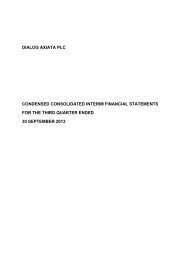
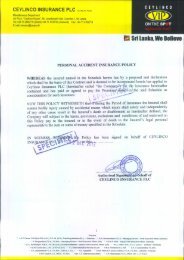
![nrypq;Nfh ,d;#ud;;]; nfhk;gdp ypkplw - Dialog](https://img.yumpu.com/15429071/1/190x245/nrypqnfh-dud-nfhkgdp-ypkplw-dialog.jpg?quality=85)
